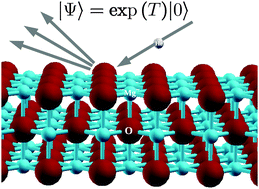Diffraction of helium on MgO(100) surface calculated from first-principles†
Abstract
In this work we simulate the diffraction peak intensities of He beams scattered on the MgO(100) surface from first principles. It turns out that diffraction peak intensities are extremely sensitive to the quality of the potential describing the He–MgO surface interaction. Achieving the required accuracy in first principles calculations is very challenging indeed. The present work describes a first principles protocol able to achieve very high accuracy for reasonable computational cost. This method is based on periodic local second-order Møller–Plesset perturbation theory where systematic corrections for basis set truncation and for high-order electronic correlation are introduced using coupled cluster calculations on finite model systems mimicking the target system. For the He–MgO system the requirements with respect to the level of theory are very high; it turns out that contributions from connected quadruple excitations are non-negligible. Here we demonstrate that using this protocol, it is possible to reach the accuracy in the He–MgO potential that is required to predict the observed He diffraction peak intensities.

- This article is part of the themed collection: High performance computing in the chemistry of materials

 Please wait while we load your content...
Please wait while we load your content...